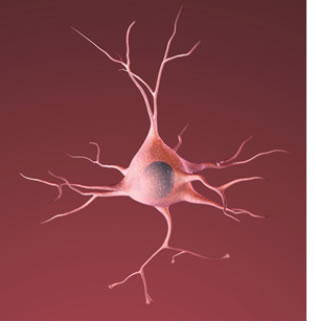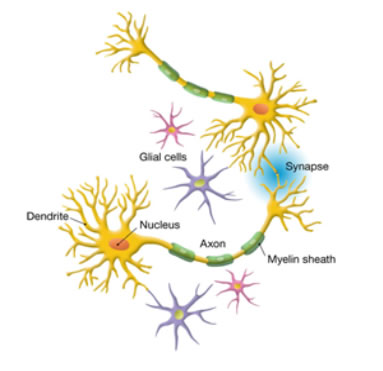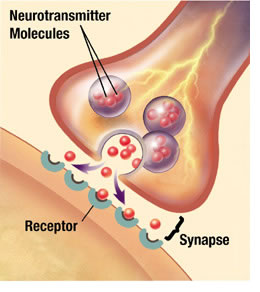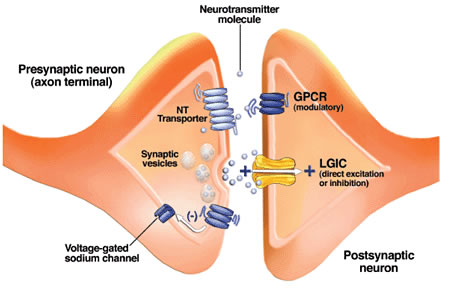Nervous System
The nervous system is divided into two general divisions. The central nervous system, which consists of the brain and the spinal cord, is one division.
The second division is the peripheral nervous system, which is divided into the somatic nervous system (the skeletal muscles) and the autonomic nervous system (the glands and internal organs).
 Photo Citation: National Institutes of Health. (2013). Central nervous system and peripheral nervous system [Image]. Available at: http://www.nlm.nih.gov/medlineplus/ency/imagepages/8679.htm
Photo Citation: National Institutes of Health. (2013). Central nervous system and peripheral nervous system [Image]. Available at: http://www.nlm.nih.gov/medlineplus/ency/imagepages/8679.htm
The image is a diagram of the central nervous system with lines pointing to the brain and spinal cord and the peripheral nervous system with a line pointing to the peripheral nerve in the upper arm.
The autonomic nervous system is further broken down into the sympathetic nervous system (gets the body ready for action) and parasympathetic nervous system (brings the body back to homeostasis or normal situation).
The neuron or nerve cell is the basic unit of the nervous system. Neurons make up the communication network throughout the body. They carry messages all over the body.
 This is a microscopic image of a healthy neuron.
This is a microscopic image of a healthy neuron.
Photo Citation: U.S. Department of Health and Human Services. (2013). Healthy neuron. [Image]. Available at: http://www.nia.nih.gov/alzheimers/scientific-images
The neuron consists of three basic parts that enable it to communicate with other neurons.
The first part is the dendrite, a tree-like process, which carries the information to the cell body from other neurons.
The second part is the cell body which contains a nucleus and is the part that will decide if the neuron will fire or not and it also directs the building of the neurotransmitters.
The third part is the axon and its job is to carry information to other neurons.
 Photo Citation: U.S. Department of Health and Human Services. (2011). Neuron cell. [Image]. Available at: https://www.nichd.nih.gov/news/releases/Pages/012811-communication-between-brain-cells.aspx
Photo Citation: U.S. Department of Health and Human Services. (2011). Neuron cell. [Image]. Available at: https://www.nichd.nih.gov/news/releases/Pages/012811-communication-between-brain-cells.aspx
Some axons are covered with a fatty sheath, called myelin sheath and it allows the message to travel faster. Neurons are not connected and have a space between them, called a synapse.
The message travels down the neuron from dendrite to cell body, to axon over the synapse, to other dendrites.
An axon may branch and connect, across a synapse, with the dendrites of many other neurons.
 Photo Citation: U.S. Department of Health and Human Services. (2009). The neuron. [Image]. Available at: http://stemcells.nih.gov/info/scireport/pages/chapter8.aspx
Photo Citation: U.S. Department of Health and Human Services. (2009). The neuron. [Image]. Available at: http://stemcells.nih.gov/info/scireport/pages/chapter8.aspx
Neurotransmitters are stored in the axon terminals in structures called synaptic vesicles.
These chemicals will bridge the synapse gap to carry the message on. Neurons communicate with each other through an electrochemical process.
When a nerve is stimulated, an action potential (a change in the electrical voltage between the inside and outside of an axon) occurs and produces an electrical impulse which travels down the axon.
 Photo Citation: U.S. Department of Health and Human Services. (2013). Neurotransmitters. [Image]. Available at: http://www.nia.nih.gov/alzheimers/features/findings-memory-research-continue-fascinate
Photo Citation: U.S. Department of Health and Human Services. (2013). Neurotransmitters. [Image]. Available at: http://www.nia.nih.gov/alzheimers/features/findings-memory-research-continue-fascinate
Visit All you need to know about neurons to learn more about how neurons carry informatoin throughout the human body.
This electrical message travels down the length of the axon and when it gets to the end of the axon terminals it stimulates chemicals inside the synaptic vesicles, called a neurotransmitter, to diffuse and carry the message across the synapse like a bridge to the receptor dendrites of other neurons.
Neurotransmitters, simply put, are the chemicals released by neurons, which determine the rate at which other neurons fire and pass along information.
 Photo Citation: National Institutes of Health. (n.d.). Schematic drawing of a synapse between two neurons. [Image]. Available at: http://pubs.niaaa.nih.gov/publications/arh313/196-214.htm
Photo Citation: National Institutes of Health. (n.d.). Schematic drawing of a synapse between two neurons. [Image]. Available at: http://pubs.niaaa.nih.gov/publications/arh313/196-214.htm
Schematic drawing of a synapse between two neurons. Synaptic vesicles contain a neurotransmitter (NT) and release it when their membranes fuse with the outer cell membrane. Neurotransmitter molecules cross the synaptic cleft and bind to receptors known as ligand-gated ion channels (LGICs) and G-protein-coupled receptors (GPCRs) on the postsynaptic neuron. GPCRs on the presynaptic neuron's axon terminal alter the function of voltage-gated ion channels and modulate neurotransmitter release. Neurotransmitter transporters remove neurotransmitter molecules from the synaptic cleft so that they can be repackaged into vesicles.
Over a hundred neurotransmitters have been identified that have many different effects on the body. For example, Dopamine is a neurotransmitter that in abundance has a link to the mental disorder, schizophrenia. A lack of dopamine is associated with Parkinson's disease.
Another example is the neurotransmitter, acetylcholine, which helps regulate the heart muscle and messages between the brain and spinal cord. Depletion of acetylcholine is associated with the Alzheimer's disease.
Endorphins are neurotransmitters that regulate the perception of pain.
Too many endorphins and the body may not give an adequate warning of pain; too few may cause a stronger sensation of pain.
Norepinephrine is associated with an increasing heat rate, arousal, learning, memory and mood.
An overabundance is responsible for anxiety and too few are associated with depression.
GABA (gamma amino-butyric acid) contributes to motor control, vision, anxiety and allergies.
Too much leads to sleeping and eating disorders, and too little has been found in Huntingdon's disease.
A final example is the neurotransmitter serotonin which is also associated with moods, emotions, and concentration. Too little serotonin may play a part in the mental disorder of depression.
You can see the importance of neurotransmitters in the activity of the brain and behavior.
The approach of neurobiology believes that understanding of the role and function of neurotransmitters will help us understand human behavior.
Part of understanding neurotransmitters requires that you take a look at drugs and the effects they have on neurotransmitters and behavior. Drugs that are typically abused alter the way people think, feel, and behave by disrupting neurotransmission, the process of communication between brain cells.
Drugs produce an altered state of consciousness which you will learn more about in a later lesson.